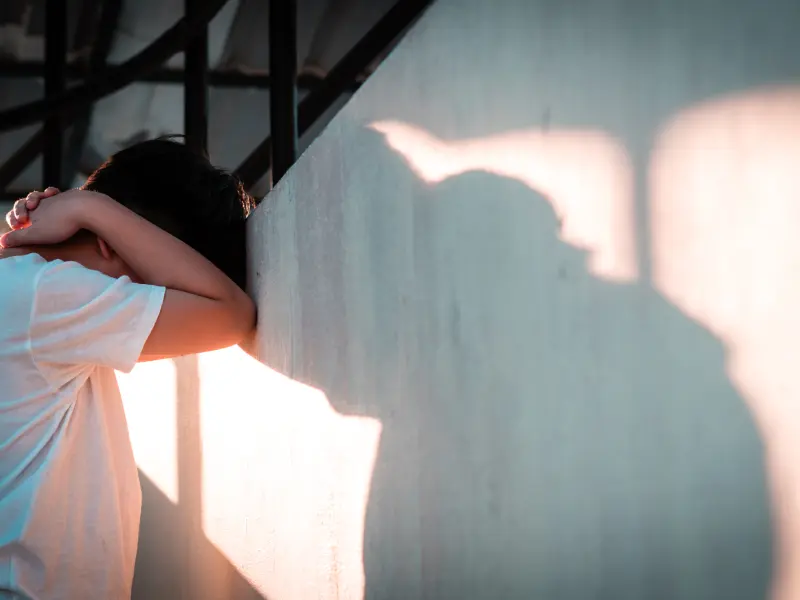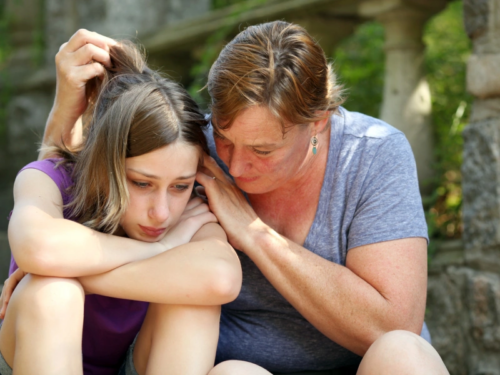
Table of Contents
Here’s How Secondary Trauma Impacts Young People

Written By: Sarah duRivage-Jacobs

Clinically Reviewed By: Dr. Don Gasparini
Updated: January 31, 2024
6 min.
The negative effects of trauma don’t stop with the person who experienced it—they can be passed on to others through family or community exposure.
Learn more about our Clinical Review Process
Table of Contents
Traumatic events like natural disasters, sexual assault, accidents, or loss can affect more than just the individual who experienced them. Some people experience trauma indirectly, as passed on through family or community exposure—a phenomenon known by experts as “secondary trauma.”
Although secondary trauma is a relatively new concept in the fields of psychology and traumatology (the study, diagnosis, and treatment of trauma), and one without a formal clinical diagnosis, we can learn a lot about it through the existing research and what we know about trauma overall. Here’s what you need to know about secondary trauma, including how it impacts young people.

Get trauma-informed care now
Virtual mental healthcare with no waitlists.
What is secondary trauma?
Secondary trauma is the experience of negative psychological and behavioral outcomes because of secondhand exposure to a traumatic event. It is sometimes referred to as secondary traumatic stress disorder, vicarious trauma, or compassion fatigue.
Secondary trauma is often written about in research as a natural outcome of professions where people provide support to trauma survivors, like social work. However, research shows that secondary trauma can also be experienced by children or adolescents with close bonds to an adult or relative who has been abused, experienced intimate partner violence, served in the military with combat exposure, or otherwise has a history of trauma or post-traumatic stress disorder (PTSD). Research has also demonstrated that witnessing traumatic events in the media can cause vicarious traumatization for young people.
The causes of secondary traumatic stress in young people
In her seminal book on burnout and secondary traumatic stress disorder, psychologist Dr. Arlene Steinberg wrote that children may experience secondary trauma in one of two main ways:
1. Directly witnessing a loved one’s trauma
The children of parents who experience intimate partner violence or sexual assault, for example, may be exposed to that trauma (on purpose or by accident) if they witness the event as it happens.
2. Knowledge of a loved one’s trauma
According to the book, knowledge is another way that trauma can be passed down generationally. In some cases, a child may hear about a parent’s trauma secondhand. For example, if a parent is managing PTSD from an adverse childhood experience or military deployment, the traumatic experience would have taken place before the child was born. Even so, the child may be aware of the trauma through conversation with the parents or through the negative outcomes of that trauma in the present day.

Secondary trauma symptoms
Studies suggest that secondary trauma symptoms parallel PTSD symptoms and signs of acute stress disorder. However, experts distinguish these clinical diagnoses and secondary trauma, which does not currently have a diagnosis in the Diagnostic and Statistical Manual of Mental Disorders (the manual behavioral health professionals use to diagnose mental disorders). That being said, common symptoms of secondary trauma include:
- Anger
- Anxiety
- Depression
- Low self-esteem
- Emotional exhaustion
- Difficulty concentrating
- Withdrawal from others
- Physical symptoms like body aches, sleep problems, changes in eating habits
How common is secondary trauma in young people?
The prevalence of secondary trauma in young people is still the subject of research. One 2021 study found that roughly one-third of people, including those under the age of 17, reported experiencing some form of indirect trauma exposure during their lifetimes.
According to the study, vicarious exposure to community trauma was more likely to lead to traumatic symptoms than family trauma exposure (although the researchers noted this may have been because community trauma was more commonly reported in the data set they examined).
The study found that White young people were more likely to experience trauma symptoms in response to vicarious traumatization than other racial or ethnic groups but were less likely to be vicariously exposed to trauma overall. By contrast, Black young people were shown to demonstrate stronger emotional and psychological resilience in the face of vicarious trauma, according to the study.

Is there anything that can prevent secondary trauma in youth?
Trauma is complex, so there’s no way to completely prevent it from happening. However, some factors have been associated with a reduced impact. According to a 2015 study, some possible protective factors for preventing a child’s exposure to a caregiver’s trauma include:
- A second parent’s mental health
- The stability of a spousal relationship
- A positive parent-child relationship
- A secure, non-threatening environment
- A community with social support
The Centers for Disease Control and Prevention (CDC) has also identified the following protective factors that can reduce children’s overall likelihood of experiencing certain kinds of trauma:
- Caregivers who build safe, positive relationships with children
- Families with strong social support networks and positive relationships with others
- Families with enforcement of household rules and monitoring of children
- Communities with safe, stable housing
- Communities with nurturing and safe childcare and after-school options
- Communities access to medical and mental health services
It’s important to acknowledge that these protective factors aren’t always within a caregiver’s or family’s control. In fact, many of these factors illustrate the need for systemic policy changes that ensure everyone has access to resources.
Supporting young people with secondary trauma
As mentioned, secondary trauma is an emergent subject, so there aren’t clear standards about what therapeutic modalities best support those who experience it. That said, several treatments have been hypothesized as possible options treatments for secondary trauma:
Cognitive behavioral interventions
The most well-known cognitive behavioral intervention is cognitive behavioral therapy (CBT), which has long been used to help people cope with challenging emotions. In CBT, clients are supported through a deeper understanding of their thought processes and patterns of feelings and behavior so they can challenge what’s no longer serving them. A form of CBT called trauma-focused CBT can be especially helpful for young people managing the effects of trauma.
Support groups
In Dr. Steinberg’s writing on secondary trauma in children, the psychologist uplifted support groups as a way for older children and adolescents, in particular, to feel understood, seek validation, and process challenging feelings around people with similar experiences. Support groups typically involve conversations among peers facilitated by a mental health professional who leads the group in developing evidence-based strategies for coping with mental health challenges.
Other forms of trauma-informed care
Any kind of psychotherapy can be trauma-informed as long as the provider aims to incorporate “the four R’s”:
- Realize trauma’s potential impact and treatment paths.
- Recognize trauma’s signs and symptoms.
- Respond by fully integrating trauma knowledge into practice.
- Resist re-traumatization of people receiving care.
For young people managing the effects of direct trauma, trauma-focused CBT and eye movement desensitization and reprocessing (EMDR) therapy have been recommended as the most effective therapeutic modalities by the World Health Organization.
Lessons from secondary trauma in healthcare professionals
In addition to trauma-informed care, we can look at advice given to healthcare professionals at risk of secondary trauma, including mental health professionals. The Administration for Children & Families advises that professionals in such roles practice self-care, get regular exercise and good sleep, and journal to process emotional experiences. These recommendations can also apply to children dealing with secondary trauma.
How Charlie Health can help young people with secondary trauma
If a young person in your life is struggling with secondary trauma or the effects of a traumatic experience, Charlie Health is here to help. Charlie Health offers a virtual Intensive Outpatient Program (IOP) that provides more than once-weekly mental health treatment for young people and families dealing with complex mental health conditions, including trauma, secondary PTSD, and more. Our expert clinicians incorporate trauma-informed therapies into individual counseling, family therapy, and group sessions. With this kind of holistic treatment, managing indirect trauma exposure is possible. Fill out the form below or give us a call to start healing today.
References
https://www.acf.hhs.gov/trauma-toolkit/secondary-traumatic-stress
https://store.samhsa.gov/sites/default/files/sma14-4884.pdf
https://www.scirp.org/html/3-6901460_56127.htm
https://link.springer.com/article/10.1007/s40653-020-00331-z
https://psycnet.apa.org/record/1998-07120-000
https://docs.rwu.edu/cgi/viewcontent.cgi?article=1252&context=fcas_fp
https://www.tandfonline.com/doi/abs/10.1080/15377903.2012.695767




